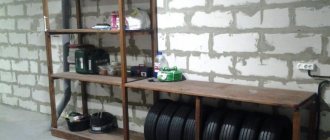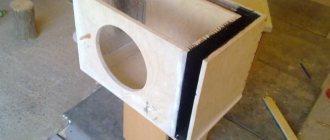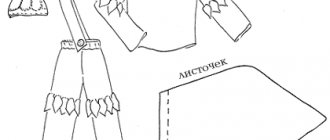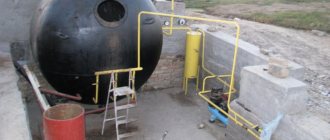There are hardly any more pressing problems in winter than problems with high-quality heating of buildings. To solve them, special equipment is used, one of the most common of which is a heat gun, in particular a gas gun. Today we will talk about how to make a gas gun with your own hands and whether this can be done in principle.
- 1 Operating principle and application of a gas gun
- 2 Types of gas guns
- 3 What will be required in the work
- 4 DIY gas gun
- 5 Trial run
Note that thermal gas guns have become very popular in our country recently. And the reason for this is not only the specific climate, but also a fairly large number of dachas and country houses. In short, such devices have a lot of advantages.
- Fairly quick installation/disassembly.
- They are safe.
- Once installed, they are immediately ready for heating.
- They are mobile and compact.
- The air in the entire room warms up very quickly.
- You can independently regulate the temperature mode.
- Finally, impressive efficiency.
Scope of application and principle of operation
The operating principle of such a unit can be compared to the operation of a fan, however, the heat gun releases warm air into the room rather than cold.
The air operating inside the housing is heated by heating elements or burners operating on various types of fuel.
The name “gun” is due to both the external resemblance of the device to an artillery gun and the powerful jet of heated air that the unit “shoots”
Heat guns of various modifications find a wide range of applications.
They are successfully used:
- in industry for heating large production and storage facilities;
- in agriculture to maintain comfortable air temperature in greenhouses, greenhouses, greenhouses;
- in construction for quick drying of plastered, painted or otherwise finished rooms;
- in everyday life for heating and drying utility rooms and garages;
- for heating residential buildings in emergency circumstances (for example, accidents on heating routes).
There are other ways to use such devices, for example, gas units are widely used when installing suspended ceilings.
What you need to know about the electric gun?
Unlike other types of heat guns, an electrical device can be made by almost any home craftsman familiar with the basics of electronics.
Although the efficiency of an electric gun is much lower than diesel or gas devices, it does not emit combustion products harmful to health and can be installed in any room - a residential building, a greenhouse, ancillary buildings.
The power of industrial guns varies from 2 to 45 kW, and the number of heating elements in them can reach up to 15 pieces
Let's look at how an electric unit works.
Design and principle of operation of the heat generator
Any electric gun consists of three main components: a housing, an electric motor with a fan and a heating element. The varieties of this type of device are described in detail in an article devoted to the classification and principles of operation of heat guns.
Additionally, the device can be equipped with any “bonuses” from the factory units - speed switch, heat regulator, room thermostat, housing heating sensor, engine protection and other elements, but they increase not only comfort and safety during operation, but also the cost of the homemade product.
The rate of heating of air throughout the entire volume of the room depends on the number and power of heating elements - the larger their area, the more active heat transfer will occur
An electric gun works like this:
- when connected to the network, the heating element converts electric current into thermal energy, due to which it heats itself;
- the electric motor drives the impeller blades;
- the fan forces air from the room inside the case;
- the cold air flow comes into contact with the surface of the heating element, heats up and, forced by the fan, is removed from the “barrel” of the gun.
If the appliance is equipped with a thermostatic element, it will stop the heater when the programmed temperature is reached. In primitive devices you will have to control the heating yourself.
Advantages and disadvantages of homemade guns
The main advantage of a thermal electric generator is the ability to use it in any room where there is a network of at least 220 W.
Such devices, even in a home-made version, are mobile, weigh little and are quite capable of heating an area of up to 50 m2 (theoretically, more is possible, but it is better not to experiment with high-power devices and buy a ready-made unit, and a gun from 5 kW will already require connection to a three-phase network) .
The performance characteristics of the device must correspond to the heated area. On average, for every 10 m2 you will need 1 kW, but much depends on the room itself - building materials, quality of glazing and the presence of insulation
Pros of a homemade electric gun:
- Saving money - factory units are not cheap, and you can assemble a heating device with a minimum of purchased parts or even completely from improvised means, removing the missing elements from old devices.
- Safety - of all homemade heat generators, the electric device is the easiest to operate, since it does not require a connection to gas or refueling with flammable fuel. With proper assembly of the electrical circuit, the risk of spontaneous combustion for such guns is minimal.
- Quick heating of the room - the work of a heat gun is much more effective than other options for homemade electric heaters, for example, fireplaces or oil radiators.
One of the disadvantages is the high energy consumption (the amount depends on the power of the engine and heating element). In addition, the operation of the fan is quite noisy, and the larger the wingspan and rotation speed, the stronger the noise produced will be.
Well, any drawback of a homemade electrical device is the likelihood of an error during assembly or connection, which can cause a short circuit in the network, electric shock and spontaneous combustion of the device.
Types of heat guns
There are several types of classification of thermal heaters.
They are most often distinguished:
- on the design of the heating element - heating method;
- by type of fuel used as a heat source.
In addition, devices can also be divided according to purpose of use into industrial and household.
Classification by heating method
Although all heat guns are used to increase the temperature in a room, depending on the design of the model, the process can be carried out differently.
Devices with direct (direct) heating
In such devices, a powerful fan takes air from the environment. Due to direct contact with the heating element, the air mass acquires a high temperature, after which it is “thrown out” into the room through a special hole.
The diagram shows a schematic design of modern heat guns with open and indirect heating, with the designation of the main structural elements (+)
Such units are relatively low cost and have solid efficiency, but they lack environmental friendliness. All combustion products formed are released into the atmosphere, which can be not only unpleasant, but also dangerous for people in the room.
To prevent this from happening, the rooms where such devices are used must be regularly ventilated or, which is much better, forced ventilation must be organized in them.
Heat guns with indirect heating
Such devices have a more complex design, which includes a heat exchanger where heat is separated from harmful combustion products. The latter are sent to a special pipe connected to the chimney, through which the exhaust is discharged from the room to the street.
In devices with indirect heating, a ring heat exchanger serves as a heating element. The presence of a chimney complicates the movement of such units, so they are most often used as stationary heat sources (+)
Although such devices are more expensive, and their efficiency is somewhat lower than that of devices with an open burner, they are still in great demand due to their environmental friendliness and safety in use.
The specific heat gun model should be selected taking into account the planned use. Options with direct heating are suitable for heating large uninhabited spaces (basements, warehouses).
If the device is intended to be used in rooms where people are present, for example, production workshops, it is better to choose models with indirect heating.
Division by fuel type
Taking into account the fuel on which the devices operate, the following types of heat guns can be distinguished:
- Electrical . Such units are environmentally friendly, they do not burn oxygen and do not emit harmful substances into the air, so they can be safely used for heating living rooms. The only downside is the rather high price of electricity.
- Multi-fuel – diesel guns or units undergoing testing. Such devices operate on waste motor and hydraulic oils that cannot be purified or used for other purposes. These devices are very economical, but they are not recommended for installation in crowded rooms, as well as in spaces where it is not easy to establish ventilation.
- Mermen . The main structural elements of such devices are a heater, a fan and a container of water. The space is heated using a powerful stream of steam. Such units are often used in agriculture, for example, to maintain comfortable air temperatures in greenhouses or greenhouses; they can also be used in residential areas.
- Infrared . Complex devices in which heat is released using infrared radiation. Such structures are excellent for heating open spaces: they can be installed on restaurant terraces, festive areas, and recreation areas.
- Gas . These models, which we will talk about in more detail below, have become widespread due to the optimal combination of quality and price.
You can often find heat guns divided into industrial and household models. The former are distinguished by high power, dimensions and high price, while the latter are small in size, lower heat emissions and affordable.
Classification by fuel type
There are many manufacturers and models of heat guns. They differ in the type of fuel they use. Varieties:
- Electrical. The air mass is heated using electric heating elements. They are environmentally friendly, do not burn oxygen from the air and do not emit substances harmful to the body. The downside is the high cost of operation due to high energy consumption.
- Multi-fuel. Used hydraulic or motor oils are used for operation. Such devices are very cheap to operate, but they should not be used in crowded areas or where it is impossible to provide good ventilation.
- Mermen. The main design difference from other types is the equipment with an evaporator. Heating occurs due to a strong flow of steam. Most often, such units are used in agriculture to heat greenhouses and greenhouses, as well as to maintain the necessary microclimate.
- Infrared. Heating occurs due to infrared radiation. These are household heaters that can also be used to heat surfaces in open spaces.
- Gas. The air is heated due to the combustion of propane or methane. You can make a gas heat gun with your own hands. It is better to use ready-made drawings.
Heat guns are often divided into household and industrial. Industrial ones have increased power, size and, accordingly, cost when compared with household ones.
Heat gun for garage from gas heater:
Characteristic features of the devices
Gas guns are used both in industry and in everyday life, for example, when heating private houses or garages. Such devices are less mobile than electric ones, but more economical and have quite high power. The figure can reach up to 150 kW.
Natural gas is used as fuel, but liquefied gas can also be used. Such devices require an electrical connection. Electricity powers the fan, thermostat, and other necessary elements.
To operate a thermal gun, different gas modifications are used:
- Liquefied butane, propane.
- Gas supplied through pipelines.
High-power modifications are connected directly to the gas pipeline through special hoses. This allows the device to operate continuously. Typically, such units are made stationary, since their movement is quite difficult.
There are also several types of gas modification in a heat gun
Compact devices run on bottled gas. Some models provide a connection to a large cylinder via a hose, while others have a special compartment with gas. Also, most models have additional elements that ensure safety during operation of the device: case protection, flame level control, automatic shutdown system.
Features of gas heat guns
Gas guns are often used not only in industry, but also in everyday life, for example, for heating country houses or garages. Such devices are inferior to electric ones in terms of mobility, but are more economical. In addition, such devices have quite high power, which can reach 140 kW.
Heaters can run on natural or liquefied gas, but they also need access to electrical networks, since the operation of the fan, thermostat and other components is impossible without electricity.
Various modifications of natural gas can be used to operate gas heat guns:
- blue fuel passing through highways;
- butane or propane in specialized cylinders.
High-power models can be connected to the gas pipeline with a special hose, which ensures their continuous operation. It should be noted that such units are usually stationary, since their movement is somewhat difficult.
Compact mobile devices operate on bottled fuel. In some cases, the gun is connected by a hose to a large cylinder, which stands motionless. In others, a small gas tank is an element of the unit’s design.
To operate portable gas devices (made independently or in the factory), gas is used in cylinders of various types
Many modern models of gas heat guns provide additional functions, for example, protection of the housing from overheating, automatic shutdown of the device, and flame control.
Additional information about the device and various modifications of gas guns is provided in this article.
Required materials and tools
It is important to understand that homemade production of gas heat guns should only be carried out with proper qualifications and extensive experience in working with gas and tools. If you take on work unprepared, it can lead to irreversible consequences.
To make a gas gun you will need the following tool:
- Metal pipe. Fuel will be supplied through it to the main system.
- Bulgarian. It is better to use 125, as it is more convenient to work with.
- Sheet steel.
- Electric drill and metal drills.
- Steel tube with a diameter of 8 mm. It will be used to make a heat exchanger.
- Thick reinforcement for the stand on which the gun will be located.
- Fan power – from 12 W.
You can use a welding machine to speed up the process. You can also buy paint that is resistant to high temperatures in advance.
When creating this gun, do not forget about safety precautions
Conclusions and useful video on the topic
The posted video clearly shows the process of creating a gas heating device with your own hands.
A gas heat gun is a powerful device that can heat even a large room in the shortest possible time. Such units can be purchased in specialized stores or made with your own hands.
In the latter case, one should understand the complexity and responsibility of this task, since handling gas appliances requires careful work and strict adherence to safety rules.
Do you have experience building a heat gun? Or still have questions on the topic? Please add comments, participate in discussions on the article and attach photos of your homemade products. The communication block is located below.
Making a heat gun - instructions
Next, we’ll look at several popular models of heat guns and DIY methods.
Gas heat gun
A gas heat gun is an effective and economical way to heat large areas.
There are 2 main types: stationary, connected to a gas pipeline, and mobile, for which cylinders are used. Mobile options are used by builders when working in winter; they are used in greenhouses and garages. According to the heating method, they are distinguished:
- Direct heating devices, when the gas from the burner directly enters the fan, and then into the room. The efficiency of such a heat gun is about 100%, although it is not the healthiest.
- Indirect heating devices. Here the gas is heated by a special heat exchanger, and the combustion products go into the chimney, just like in a gas boiler. The efficiency of such a heat gun is lower, but it can be used in residential premises without fear.
To create a simple heat gun of the first type with your own hands you will need:
- An old gas or welding cylinder or thick-walled pipe.
- Fan.
- Gas nozzle with divider.
The bottom of the cylinder is cut off.
A burner and ignition device are installed inside.
A fan is attached to the outlet.
Gas hose and electrical cable are supplied.
The supports are welded or screwed on so that the heat gun does not lie on the floor.
After testing, the device is ready for use.
Electric heat gun
The design of an electric gun is not very different from a gas gun, only heating elements are installed instead of a burner.
Basic assembly aspects:
- The length of the pipe for the housing is taken from the calculation of the length of the heaters and the distance of at least 20 cm between them and the fan.
- The wiring of heating elements and fans must be autonomous, with mandatory grounding.
- A thermostat is required to increase/decrease heating.
- Ideally, protection against overheating is needed.
When assembling and operating an electric heat gun, it is important to follow safety rules when working with electric current.
Heat gun on diesel fuel and diesel fuel
This is the most dangerous type of heat gun, so assembly requires increased care and attention.
The housing will require a sealed tank, which will be divided into a heat exchanger and a combustion chamber. The ideal option would be an old wood-burning boiler or stove.
Using a pipe, burning diesel fuel enters the chamber from the burner and passes through the heat exchanger. Combustion products are removed into the hood.
The fan forces cold air into the housing, creating a flow of heated air from the nozzle.
Wood fired heat gun
A wood-burning heat gun is similar to a diesel heat gun, but is somewhat safer and smells significantly less. In the combustion chamber, instead of a pipe and a burner, a door for firewood, an ash pan and grate bars are installed. A wood-burning gun is heated similarly to a wood-burning boiler, the only difference is the presence of a fan.
Features of repair of diesel guns for space heating
Repair maintenance for a diesel fuel-powered installation can cost a significant amount. Just one diagnostic procedure costs about 1000 rubles. For this reason, many owners of garages and warehouses resort to self-repair of structures.
How to repair a diesel heat gun yourself
If warm air does not move, the fan motor may be faulty. Repair involves cleaning the terminals, checking the winding on the motor (an analog tester is suitable for this), as well as insulation. Sometimes the damage is so serious that superficial adjustments are not enough. In such cases, there is only one thing left - replacing the engine.
An important design detail is the nozzles. The quality of operation of these elements depends on the full functioning of the entire heating system. These parts rarely break, and new elements to replace failed ones can be bought at any store.
These parts rarely break, and new elements to replace failed ones can be bought at any store.
Modern heat guns are equipped with a convenient control panel that allows you to adjust the air heating temperature
Much more often, the need to repair a diesel gun arises due to a clogged filter. To eliminate this breakdown, simply open the housing of the structure, unscrew the plug and remove the contaminated element. After washing with clean kerosene, the filter is ready for further use. Before installing this part in place, it is advisable to blow it out with a jet of compressed air.
Rules for the safe operation of diesel appliances
When operating diesel appliances, it is very important to adhere to basic safety requirements. A container filled with fuel must not be placed closer than 8 m from sources of open fire and any heating devices. Important! It is not allowed to use gasoline instead of diesel
The volatile components of this substance increase the likelihood of an explosion several times
Important! It is not allowed to use gasoline instead of diesel. The volatile components of this substance increase the likelihood of an explosion several times. The room with a working gun must be left at the first appearance of these symptoms:
The room with a working gun must be left at the first appearance of these symptoms:
- severe dry mouth;
- pain and discomfort in the nose and throat, as well as the eye area;
- headache that appeared suddenly;
- nausea.
Professional model of a diesel fuel heat generator from the Master company
The presence of carbon monoxide in a closed room negatively affects the condition of people suffering from diseases of the cardiovascular system and lungs. The presence of pregnant women and patients with anemia in the room where the gun is operating is not allowed.
Due to their efficiency, diesel guns are in great demand on the market. By following basic operating rules, you can avoid health problems. Otherwise, using a diesel gun is not dangerous. A high-quality device with suitable technical characteristics can provide a garage or warehouse with effective heating for many years. The design of these devices is so simple that most of the breakdowns that occur during operation can be eliminated by the owner without intervention from specialists.
Rules for using a heat gun in the garage
When heating a garage using homemade heaters, especially with an open flame, it is important to follow fire safety measures:
- It is imperative to install a reliable ventilation system in the garage, preferably forced;
- the open flame of the heat exchanger must be covered with a heat-reflecting protective screen;
- containers with fuel should be located as far as possible from the operating heater;
- do not leave a working device in the garage overnight - this is dangerous;
- the distance from the car’s gas tank to the gun should be no less than one and a half meters.
Installing an ignition system on an Apple Gun
Ignition system
Spark gap
The main mistake when building potato cannons is supplying voltage inside through metal elements. As a rule, after several shots, such a gun becomes silent for a long time due to loss of spark. This design does not have this drawback. At a distance of 40 mm from the end of the plug, we drill two holes and insert conductors there to a length of 40-50 mm. We fix the wires in the holes with hot glue. After the glue has set, we form a spark gap and check the spark. The iska will skip with a characteristic sound. To be on the safe side, the place where the conductors enter is secured with reinforced tape in two layers.
Step-by-step instruction
The first step is to make the body. You can use sheet steel 3-4 mm thick or a regular pipe. The sheet needs to be given the required parameters, and then it needs to be rolled into a pipe. The edges are secured with bolts or a special connecting lock.
After this, the pipe that is used to supply gas is sawn. This is necessary so that later it will be possible to weld the next element to it.
Homemade gas gun:
Now it is necessary to increase the diameter of the hole, which is intended for gas to enter the system. You need to bring it to 5 mm.
Then the heat exchanger . Take a metal pipe with a diameter of 80 mm. The end must be welded to the burner wall and a hole must be drilled. The burner extension passes through this element.
To allow the heated air to escape, a hole must be made in the heat exchanger housing. Then weld a tube with a diameter of 8 cm in that place.
Then a fan is installed to circulate the hot air. It is also necessary to provide for the supply of electricity. You can connect it to the network or battery.
Finally, you need to drill holes to ignite the gas. It is also necessary to provide a structure on which the heat gun will be located. You can use a ready-made stand or weld it from reinforcement.
Heat gun. with your own hands:
Making a gas heat gun with your own hands
First of all, we emphasize that only craftsmen with extensive experience and proper qualifications can undertake the independent production of gas heat guns.
A detailed diagram that you can use when making your own gas heat gun. A similar device is suitable for heating a garage or other spaces (+)
If you are confident in your abilities, then you can start working by selecting the necessary devices and materials.
List of tools and materials
To make your own gas heat gun you will need:
- a metal pipe through which fuel will be supplied to the system;
- Bulgarian;
- steel sheet;
- drill with drill bits for working on metal;
- metal strips (thickness 2 mm);
- 8 mm steel tube for the heat exchanger;
- fittings for the stand on which the gun will be placed;
- fan with a minimum power of 12 volts.
You may also need other equipment, such as a pipe welder.
Step-by-step instructions for making the device
First of all, you should take care of the body. It can be made from an ordinary pipe or a casing can be made from a sheet of steel of medium thickness. The metal must be cut, giving it the required parameters, and then rolled into a pipe. The edges are fastened using the connecting lock method or ordinary bolts.
Then you need to use a grinder to cut the tube intended for conducting gas into the system. This is necessary in order to further lengthen this element by welding to it the same part with a similar diameter.
Next, you need to slightly expand the hole through which the gas will flow, bringing it to 5 mm.
To increase heat transfer, it is also advisable to lengthen the body using a metal disk with a diameter of 8 cm, which is fixed under the burner. Eight holes with a diameter of 1 cm should be drilled on it, which ensures easy access of air.
After this, you should start making a clamp with which the heat exchanger will be fixed.
Two thin metal plates two millimeters thick, firmly welded in a cross-shaped manner, will further improve the process of heat transfer and distribution
Next, you can begin manufacturing the heat exchanger. To do this, you should take an iron pipe with a diameter of 8 cm, which has not too thick walls. We weld the end to the wall, where you also need to drill a hole.
An extension cord from the burner is passed through this part, while the clamp located at the end is additionally strengthened with bolts.
To release hot air into the room, a pipe with a hole made is welded to the pipe, the length of which is approximately 80 mm
You should also start assembling all the burner parts, and install a switch for the fan into the heat exchanger housing.
In the body of the thermal energy exchanger, it is necessary to make a hole using a grinder, to which the cut part of the 80 mm tube is attached. It will serve to release heated air.
An important part of a gas heat gun is the fan. You can use a car or household appliance. It is desirable that it have a round shape, but a square model can also be used
After this, you can proceed to installing a fan at the second end of the heat exchanger. Through this part, heated air will be transferred to the cold space. It is also necessary to consider the energy source for the fan. As a rule, it is connected to the mains, but it is possible to use a battery.
The final stage of making a homemade cannon is drilling the holes necessary for convenient ignition of gas.
It is also important to consider the design on which the gas gun body will be installed. You can take a ready-made suitable stand or use the iron reinforcement from which the frame is made.
To accurately regulate the air flow, it is advisable to install a limiter on the heat gun. A damper located between the fan or mounting flanges can be used.
How to do a test run
After assembling the structure, it should be connected to a pre-prepared gas cylinder using a tube.
the pressure in the cylinder or in the pipe must meet the requirements of this heating device model: the more powerful the device, the greater the pressure it needs (for a 10 kW unit, the pressure must exceed 0.5 bar)
In order to check the assembled structure, it should be tested:
- a lit lighter is brought to the ignition hole;
- the valve opens to provide gas access;
- immediately after the fire appears, the lighter is hidden;
- The fan on the device turns on.
If assembled correctly, the gas burner will burn evenly and release heat immediately. A similar algorithm of actions should be used the next time the device is turned on.
Trial run
To use the gun you need to perform some procedures.
- We light the lighter by bringing it to the fuel ignition hole.
- Open the valve so that gas begins to flow.
- When the gas lights up, put the lighter back.
- Turn on the fan.
If we briefly consider the manufacturing technology of this kind of heat gun, it looks like this:
- We attach a metal extension disk to the burner;
- we extend the pipe necessary for gas supply to the device;
- we install iron plates necessary to improve heat transfer;
- install the clamp on one side of the extension, after which you need to secure the heat exchanger itself;
- We assemble the entire heating device;
- we make holes in the heat exchanger so that hot air can escape through them;
- We weld a metal ring to the second end of the pipe;
- We install a switch on the heat exchanger that will turn the fan on/off;
- fan assembly itself.
Do not forget that a DIY gas gun also needs a housing. This body, as you know, most closely resembles an ordinary pipe, so we can easily make it ourselves. To do this, take a sheet of steel that is not too thick, cut it to give it the required size, and roll it into a pipe.
In order to connect the edges of the sheet together, you can resort to the connecting lock method. If for one reason or another you cannot do this, then use regular fastening bolts.
Well, so we looked at the features, operating principle and manufacturing technology of such a device as a gas heat gun. This device is very popular due to its efficiency and the ability to heat large areas in record time. You can do it yourself, just have a list of necessary tools, materials, and a little patience.
Electric gun manufacturing options
The most difficult stage when assembling a device is to draw up the correct electrical circuit diagram for connecting the device to the network. Therefore, we suggest using a ready-made example, taking it as the basis for a future heat gun. As can be seen in the diagram, the toggle switch and thermostats must be connected in series, and the circuit must be closed on the heating element and the electric motor with the fan.
Let's look at the manufacturing features of two simple options.
A simple fan heater with a ready-made heating element
For the body of the future gun, you can select a piece of metal or asbestos-cement pipe of a suitable diameter. It is best to adjust the size according to the wingspan of the fan, because it should overlap one of the ends of the device.
If desired, the heat generator can be made from a small metal tank, a galvanized bucket, an old saucepan or a waste gas cylinder, the main thing is that the walls of the casing are not thin.
As for the heating element, you can remove this element from a used tile or boiler, or purchase it in a store - now it’s not a problem to find a heater of any shape. If you buy ready-made, the best option would be a finned part, specifically designed to quickly warm up the moving air flow.
In addition to the three main elements (housing, motor and heating element), for work you will need a three-core cable, bolts, circuit breakers and residual current devices (RCDs) that disconnect the network in a dangerous situation.
Step-by-step work plan:
- Determining the required power for a future electric gun . As a starting point, you can take the common formula, according to which 1 kW is required per 10 m2 (with a ceiling height of 2.5-3 m). And if the room is not insulated, is located in the basement or has a large glass area, feel free to add another 20-30% to the data obtained. But if the required power exceeds 2.5-3 kW, think about whether your wiring can withstand such a load.
- Manufacturing of the body . If it is a metal sheet, it needs to be bent and fixed in shape by welding, hoops or rivets. For a bucket, cylinder or pan, saw off the bottom and lid. In short, the result should be a cylindrical or rectangular frame with two open holes at the ends.
- Checking the resistance of the heating element and comparing it with the calculated one . If necessary, you can add 1-2 more elements by connecting them in series, or increase the power by shortening the element.
- Mounting the electric motor with a fan (standard fasteners can be used). The impeller should close the gap as tightly as possible, but at the same time rotate freely. The wires are connected to the network through a 6A fuse and are equipped with a switch.
- Fastening the heating element inside the pipe (approximately in the center) using rivets or plates made of refractory materials. The distance should be far enough away from the fan so as not to overheat the electric motor. The wires are led out of the housing and are also connected to the network, but through a 25A fuse.
After checking the insulation of all connections, you can test run the device. If everything is assembled correctly, when you plug the plug into the socket, a fan will begin to rotate at one end of the gun, and warm air will come out of the other, gradually increasing in temperature.
Device with nichrome heater
If you don’t have an old household appliance in your home craftsman’s arsenal from which you can remove the heating element, but for some reason you don’t want to buy a ready-made heater, you can make it yourself from a nichrome spiral.
In addition to low cost, such an element has an important advantage over factory-made copies - the ability to independently adjust the desired size to the body format and increase the heating rate to a safe maximum.
For homemade products, you will need to buy nichrome wire with a suitable diameter and resistance parameter. And this depends on the planned power of your device (for household devices and a 220 V network, it is advisable not to exceed 5 kW).
For example, for a gun up to 2 kW you will need wire with a resistance of 27-30 ohm, which must be wound on a ceramic rod or other heat-resistant material (in extreme cases, you can break off a plate of refractory brick).
Another option is to make a homemade heating element from a small piece of asbestos-cement pipe, placing a coiled spiral of the same nichrome wire inside. The coils can be arranged horizontally and vertically to cover a larger area.
The assembly of the structure is carried out by analogy with the instructions described above, so we will not repeat the same points, but will only consider the nuances of connecting a homemade heating element:
- To keep the spiral in the correct shape, make special notches on the rod for each turn. The wire must be wound tightly enough, but always in one layer.
- The ends of the wire must be connected to electrical wires using bolted connections and insulated.
- The wires brought out through the holes drilled in the housing must be connected to the network through a 25A fuse.
A significant drawback of such a homemade product, in addition to energy consumption and other disadvantages of electric guns, is the unpleasant burnt smell that arises from the combustion of dust on an open coil.
Many people recommend installing a grate at the ends - such a barrier, of course, will not cope with small debris, but will protect against accidental contact with the heating element or operating impeller.
Safety precautions
This device is a fire hazard, so all safety rules must be followed. Requirements for operating the device:
- A homemade gas gun cannot be left unattended. Factory ones often have an automatic safety system that shuts off the gas supply in emergencies.
- Do not use the devices in places where flammable objects and substances are located.
- Good ventilation of the room must be ensured.
- The open air heating device should be placed only on flat surfaces so that the position is stable.
- Cannot be used outdoors during rainfall.
Before using the device, make sure that the outlet is grounded. The ends of the gun can be covered with a metal mesh to disperse the air flow.
Types of diesel heat guns
Guns of this type are also called liquid fuel: they can use either diesel, kerosene or diesel fuel as fuel. It is strictly forbidden to use gasoline, alcohol or other flammable liquids to refuel such devices.
Diesel heat guns can be not only mobile, but also stationary. Such designs have an outlet pipe connected to a chimney through which combustion waste is removed
The choice of fuel must be approached very carefully, since the use of low-quality or contaminated fuel may clog the injector and/or filter, which will require the intervention of repairmen.
Diesel guns are distinguished by their high power, high efficiency, and compact size, making such units quite mobile.
All units operating on economical diesel fuel can be divided into two groups of heat guns: with direct and indirect heating.
Devices with direct heating. The operation is based on an elementary principle: a burner is installed inside the housing, through the flame of which air blown by a fan passes. As a result, it heats up and then bursts out, releasing heat into the environment.
A diesel heat gun with open heating cannot be used for heating residential premises, since its design does not provide exhaust pipes. As a result, waste substances, including carbon monoxide, enter the room, which can lead to poisoning of the people in it.
Such devices are characterized by high power of 200-250 kW and almost 100 percent efficiency. They are inexpensive and easy to install, but have an important drawback: not only the heated air flow enters the outer space, but also combustion products: soot, smoke, fumes.
Even good ventilation will not be able to completely rid the air of unpleasant odors and tiny particles, and if it is completely absent, living creatures in the room can become severely poisoned.
A device with indirect heating is much more complex. In such models, the air is heated indirectly, through a special chamber - a heat exchanger, where heat is transferred to the air flow.
Diesel heat guns with indirect heating are more expensive and have lower efficiency compared to similar products with a direct heat source. However, they are widely used due to their better environmental friendliness and safety.
In such units, heated exhaust gases, together with heat, enter a heat exchanger, from where they are discharged into a smoke duct, to which a special pipe is connected. With its help, combustion products are removed from the enclosed space to the outside, providing fresh air in the heated room.
Heat guns with indirect heating are often used to heat a garage.
Models of diesel heat guns with high power may have large parameters. They are used to heat large premises: warehouses, factory floors
The advantages of such models include:
- Mobility. Although the dimensions and weight of such devices are somewhat larger than their analogues with open heating, they still have a fairly compact size, which allows them to be transported around the room within the length of the connecting element and the chimney.
- Great power. Although this figure is higher for devices with direct heating, the power of indirect diesel guns is enough to heat a large space in a short time.
- Reliability. Such devices have a well-thought-out design, which minimizes the risk of fire and also increases the durability of the guns.
- Availability of a protection system. Many factory models are equipped with a protective complex that automatically turns off the gun immediately after the room temperature reaches a predetermined value.
- Reduced risk of burns. Products manufactured at the factory are equipped with thermal insulating gaskets that prevent the body from heating up, which reduces the likelihood of injury to the user.
- Duration of work. Some models have large-volume tanks, which allows you to use them for a long time without worrying about fuel.
The disadvantage of such structures is the high noise level, especially for high-power units.
Main malfunctions of gas heat guns
Most gas gun malfunctions can be fixed independently, without going to a workshop. Most often the following fail :
- fan;
- piezoelectric element;
- burner;
- security elements.
Typically, owners of these devices encounter the following problems :
- It is impossible to light the gas . This is how the piezoelectric element malfunctions. It should be cleaned, and if this procedure does not help, then replace the part with a new one.
- Gas does not enter the combustion chamber . The cause of this malfunction is a clogged burner. The problem is solved by blowing the burner with a powerful air jet.
- There was a smell of gas . This problem is usually caused by gas leaking from the hoses. Either tightening the fasteners or replacing the hoses is required. The easiest way to identify gas leaks is to use a soap solution.
- Gas consumption has increased - the gearbox needs to be replaced.
- When the burner is burning, warm air does not flow into the room - you should check the serviceability of the fan. If there is power supply and the contact group is in good condition, it needs to be replaced.
Purchasing a gas heat gun equipped with all the necessary safety elements will cost the buyer a substantial amount . Such an acquisition is justified when there is a constant need to heat large areas.
Therefore, many people make heat guns that run on gas fuel on their own. In this case you should remember that such devices should not be left to work unattended under any circumstances.
How to choose a gas gun in a store and what to look for
When choosing a gas gun for domestic use, you should first pay attention to the following parameters:
- Power. It is measured in kW; sometimes manufacturers additionally indicate the volume of heated air per 1 hour of operation. In the first case, the formula is followed: 1 kW per 10 m2 – minimum. Secondly, it is necessary to calculate the total volume of the room planned for heating with a gun and divide the resulting figure by 2. This will give the minimum power of the gun, with which the room can be heated within 30 minutes of continuous operation of the heater. For example, the volume of air heated by a gun is 300 m3. Accordingly, it is optimally suited for a room with a volume of 150 m3 (volume and area should not be confused - these are completely different indicators).
- Connection type. This means with a closed or open burner. The first ones are more expensive and they are used for “emergency” heating of residential premises. It is not worth buying them for other purposes. Open ones are the best option for garages, sheds, warehouses and other non-residential premises.
- Presence of automatic arson. In principle, the function is not required. Moreover, piezoelectric elements fail quite quickly, but their presence increases the cost of the gun by almost 10–20%.
- Availability of additional functions. This means adjusting the fan speed, sensor system, thermostats, and so on. All of them help automate the operation of the gun, but manufacturers do not recommend leaving heaters of this type running without supervision. And the presence of those same sensors also increases the final cost of the device. If you need to save money, you can buy a gun without all these sensors.
- Power supply for fan. Available either from 220V or 12V DC. The last option is convenient because the gun can be used as a mobile gun, launching it even in the absence of a household electrical outlet. If such functionality is not needed, then it is better to take it with the simplest 220V motor. Even better - without brushes (such motors are very reliable and durable, but are quite expensive).
The principle of operation of a gas gun
Table 1. Key parameters of gas guns that must be taken into account when purchasing.
| Power | Not less than 1 kW per 10 m 2 of heated room |
| Type of gas the gun operates on | Methane - for connection to the household gas network, propane - for cylinders. There are also “universal” guns, but they are expensive and often break down due to the complex technical design (there are 2 separate valves working at the same time) |
| Auto-arson | It is recommended to take one without automatic ignition - such models are cheaper, their starting is not dangerous |
| Availability of additional sensors | Not necessary. Most of them will not be used by anyone - tested in practice |
| Fan motor power supply | With support for connecting to 12V, buy if the heater will be used as a mobile one. In other cases - only 220V |
| Closed or open burner | Closed - for heating residential premises, open - for everyone else |
An option for using gas guns is for installing suspended ceilings. Under the influence of high temperature, PVC fabric easily stretches, there are no folds or dents left on it
Biemmedue: quality + Italian design
The Italian company, established in 1979, specializes in the production of heaters, generators, dehumidifiers and other heating equipment.
The products, which include both household and industrial models, are distinguished by durability, reliability and excellent quality.
The manufacturer pays attention not only to technical characteristics, but also to design. All lines developed by Biemmedue are distinguished by their compact size, mobility, and aesthetic appearance.
Master: a company with vast experience
An American company that has been producing portable heating systems, including various types of heat guns, for more than half a century. For the manufacture and design of units, only high-quality materials are used, thanks to which the company’s products are distinguished by high technical characteristics.
The diesel heat gun Master BV 110 has excellent characteristics (power 33 kW, 65-liter fuel tank, fuel consumption 2.71 per hour). Within an hour, the unit can heat 460-1000 cubic meters. m of air
Thanks to the innovative technologies used in the production of models, heat guns have many useful additional options, for example, a flame control function or emergency automatic shutdown in case of an unusual situation.
Kroll: innovative technologies
Heating equipment, produced by the well-known German company Kroll , is distinguished by a high level of assembly and the use of high-quality materials, primarily stainless steel. The latest engineering and scientific developments are widely used in the production of products, including diesel heat guns.
Products from other companies (Vitals, Ballu) are also popular. Products manufactured on the production lines of these transnational companies are reliable and have a long service life.
Every year you can see interesting new items in the product range: for example, the latest models of the company’s heat guns are equipped with a heat heating function, thanks to which the devices can operate successfully even at low temperatures.
Popular models of factory gas heat guns
If it is not possible to make a gas heater yourself, you can study the modern market of heating appliances and choose the best option.
Some of the most popular companies producing gas heaters include companies such as:
- Ballu;
- Fubag;
- Neoclima;
- Master;
- Resanta;
- Interskol.
According to a survey conducted among users of specialized forums, the top included the following models: MASTER BLP 17M, Neoclima IPG 15, Interskol TPG-15.
All gas heating appliances from the famous American company MASTER are distinguished by high-quality assembly, reliability, efficient operation, and excellent design.
MASTER BLP 17M . The unit has an adjustable power of 10-16 kW, making it possible to maintain a comfortable temperature in a room with a volume of up to 655 m3.
Power is supplied by connecting to a gas cylinder through a reducer and connecting to a household electrical outlet. Mechanical ignition causes some inconvenience.
Neoclima IPG 15 . A device with a power of 18 kW is capable of heating a room measuring 400 m3, while the fuel consumption is 1.4 kg/h. The model also includes a hose and a gas reducer.
The Fubag Brise 15 model has a power of 18 kW. It features minimal fuel consumption. Heating a room with a volume of 500 cubic meters will require only 1-1.2 kilograms of fuel per hour. The heat gun has a flame control device, as well as a high-quality protection system
Interskol TPG-15 . The unit has a capacity of 300 m3 per hour, the power of which can be changed within 3-15 kW, while fuel consumption will vary from 0.73 to 1.3 kg/h. Such a device can operate on both propane and butane.











